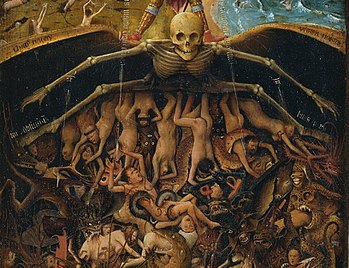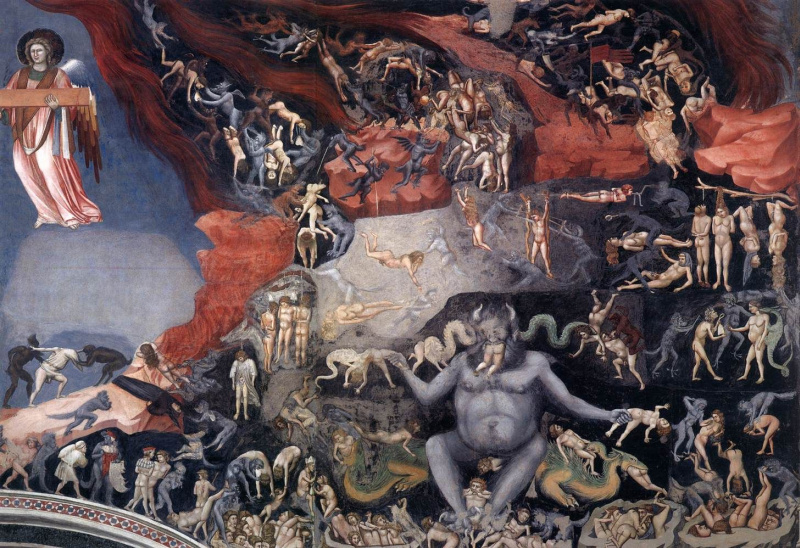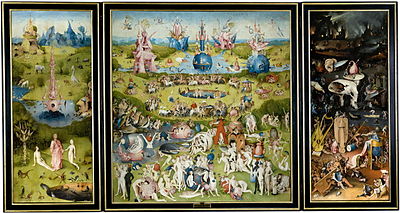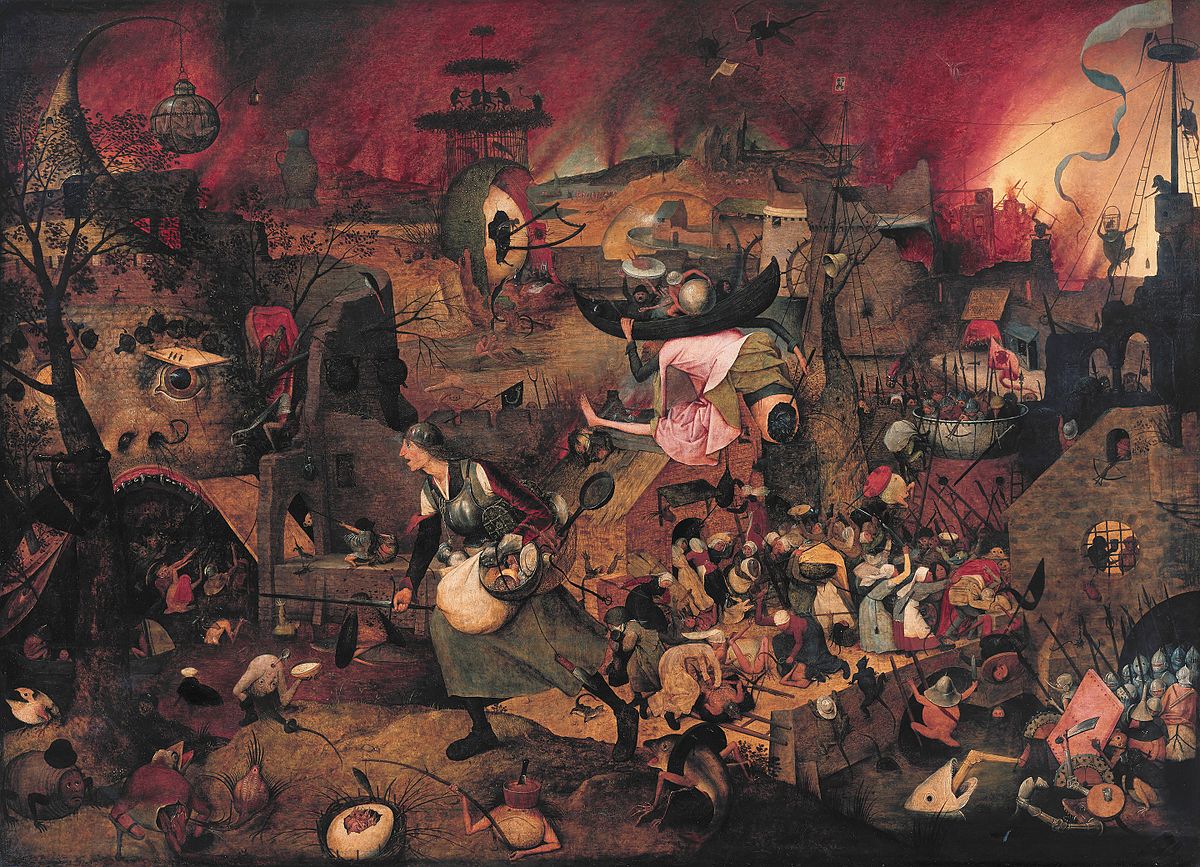Exploring Hell in Art: 11 Hell Paintings
- Giotto's Terrifying The Last Judgment (1307)
- The Chilling Last Judgment by Jan van Eyck (1440-41)
- Fra Angelico's Harrowing The Pains of Hell (1431)
- Hieronymus Bosch's Bizarre The Garden of Earthly Delights (1490-1500)
- Pieter Bruegel's Distinct Dulle Griet (1561)
- William Blake's Unexpected The Penalty of the Thieves (ca. 1824-27)
- To Bring it All Together
Dante Alighieri, a renowned poet from medieval Italy, had a vividly terrifying imagination, especially when envisioning the frightening scenes in hell. "Inferno," the initial part of his famous work "The Divine Comedy," penned in the early 1300s, is packed with monstrous creatures eager for sinners.

Jan Van Eyck, The Last Judgment, C. 1440–1441
Within a specific part, Cerberus, a three-headed beast with crimson eyes, stands guard at the underworld's gates, menacing the spirits with its sharp claws. Artists have crafted equally if not more, terrifying depictions of hell.
Western art history is brimming with artworks displaying various forms of torment—physical, mental, and spiritual. Dante's descriptions inspire some, while others use biblical depictions of hell to urge people toward virtuous behavior. Later, artists reflected on wartime, their personal struggles, or the concept of an individual's inner torment.
Here, we'll explore some of the most spine-chilling interpretations of hell, spanning from Dante's era to the present day. While some might seem amusingly absurd, they all delve into the intense mix of human fear and guilt.
Giotto's Terrifying The Last Judgment (1307)

Giotto Di Bondone, The Last Judgment In The Scrovegni Chapel, C. 1307
Giotto, an artist from Florence, had a unique talent for creating dramatic art. Like many artists of the early 1300s, Giotto crafted frescoes primarily for the chapels of affluent families.
Yet, his artwork stands apart — the biblical figures adorning his works aren't presented as two-dimensional or stylized, in contrast to his Byzantine forerunners. Instead, they display intense, genuine emotions and human vigor.

Giotto Di Bondone, The Last Judgment, Circa 1306
This distinction is most strikingly visible in the Scrovegni Chapel of Padua. Inside, the rear wall of this chapel features one of the most renowned paintings in art history, depicting the Last Judgment.
This event, described in the New Testament, portrays the ultimate moment when God decides whether the departed souls should ascend to heaven or descend to the fiery Underworld. Giotto drew inspiration from prior artistic interpretations and his own creativity to fashion a representation of hell aligned with the religious narrative.
In the lower right corner of the fresco, a horned, voracious creature (likely Satan) stands at the entrance of hell, consuming sinners and then expelling them without ceremony. The punishments are harsh and beyond imagination: undraped men and women impaled and roasted by shadowy demons or confined to deep chasms.

Giotto Di Bondone, The Last Judgment, 1306
It's believed that Dante may have visited this fresco during Giotto's work, as per Giorgio Vasari, who described them as "close" friends. Dante initiated the composition of the Divine Comedy around the time Giotto commenced the painting of the Arena Chapel.
The Chilling Last Judgment by Jan van Eyck (1440-41)

The Chilling Last Judgment By Jan Van Eyck (1440-41)
Jan van Eyck, a groundbreaking Dutch painter who emerged more than a century after Giotto, produced his rendition of the Last Judgment on one side of a diptych, accompanied by a Crucifixion on the other.
The depiction of the Last Judgment, measuring a mere 22 by 7 inches, presents a chilling piece of artwork due to Van Eyck's grim portrayal of hell, as described by Metropolitan Museum of Art Curator Maryan W. Ainsworth as "an infernal creation."
Beneath the colossal, ominous skeleton's extended arms, souls descend, each undergoing distinct forms of punishment. In a distant corner, a man is attacked by a serpent, leading to disembowelment.
A demon, resembling a fusion of a jaguar and a skull, feasts on the flesh of a figure. Ainsworth articulates the scene, illustrating "the snapping and fracturing of bones, the grinding teeth of the relentless, monstrous entities."
Fra Angelico's Harrowing The Pains of Hell (1431)

"The Torment Of Hell" By Fra Angelico (1431)
The Dominican friar Fra Angelico, also known as Fra Giovanni during his lifetime, ironically gained fame for his unsettling depictions of the underworld. His most chilling masterpiece is a mural portraying the Final Judgment. Originally created for the Basilica of Santa Maria degli Angeli in Rome, it now resides in Florence's Museo di San Marco.
In his artwork, Fra Angelico takes inspiration from Dante's writings to visualize hell as a dark, shadowy cavern. Here, the damned, organized according to their sins, endure various forms of unique torment.
Those who commit greed will find their mouths filled with gold coins, while individuals guilty of anger are endlessly compelled to engage in combat. At the fiery depths, Lucifer devours human bodies while bathing in the molten spirits' broth, stirred diligently by demons.
Hieronymus Bosch's Bizarre The Garden of Earthly Delights (1490-1500)

Hieronymus Bosch "The Garden Of Earthly Delights" (1490-1500)
Hieronymus Bosch's renowned artwork, The Garden of Earthly Delights, is a counterpart to Dante's Inferno in terms of its widespread recognition, making it a crucial reference when discussing depictions of hell.
The Dutch artist lived through the Protestant Reformation in the mid-1400s. During this period, Christians began interpreting God's teachings individually rather than relying solely on the church.
Bosch applied this approach in his paintings, illustrating hell and heaven amidst chaotic, lively scenes set against a Dutch landscape. Bosch's version of hell doesn't resemble the fiery pits described in the Bible or a traditional inferno.
Instead, it presents a surreal battleground populated by dreadful creatures that take pleasure in tormenting humans. The painting's appeal may lie in its numerous peculiar details.
For instance, a dismembered leg is showcased as a prize on the helmet of a peculiar bird-monster. Other sinners are seen being stretched out and toyed with by demons with small, gleaming eyes or being consumed by their assailants and then expelled.
Pieter Bruegel's Distinct Dulle Griet (1561)

"Excellent Dalle Griet" By Pieter Bruegel (1561)
Pieter Bruegel, the Elder, was a renowned Dutch master celebrated for his portrayals of rural life. However, he also possessed a knack for captivating his audience.
According to Leen Huet, Bruegel's biographer, the artist engaged all the senses to evoke fear and delight simultaneously. This is most apparent in his 1561 masterpiece, "Dulle Griet," which offers a unique perspective on hell within the context of Flemish society.
This painting introduces us to the legendary character Dulle Gret —a leader of a female army embarking on a mission to raid the underworld. Her colossal stature is a testament to her strength, overshadowing her compatriots and foes, who take on the form of fantastical demons inhabiting an otherwise recognizable Dutch landscape.
Bruegel's portrayal of the netherworld melds fantasy elements with the tangible world. It appears as if Griet is making a beeline for the literal "entrance of Hell," with its scale-like surface mirroring the bricks of the surrounding architecture. The inhabitants of this unique hell do not feast on the deceased but rather engage in combat with living adversaries.
Scholars have also interpreted this artwork as reflecting gender dynamics in the 16th-century Netherlands.
A 1568 book of proverbs provides a context: "One woman creates a commotion, two women cause a great deal of disturbance, three make a market, four lead to an argument, five to armies, and six against the Devil, he has no weapon."
The painting can be viewed as an exploration of female influence, with Griet portrayed as either a ruthless agent of chaos or a courageous hero, unafraid to confront the Devil head-on.
William Blake's Unexpected The Penalty of the Thieves (ca. 1824-27)

William Blake "The Punishment Of Thieves" (C. 1824–1827)
The gentle hues and flowing strokes in this watercolor by the British artist William Blake might not immediately evoke thoughts of an "inferno." However, upon closer examination, it reveals a vivid portrayal of suffering.
Blake crafted this scene as part of a series designed to illustrate his interpretation of The Divine Comedy. He took on the commission because, as Maria Popova notes, "Dante's disdain for materialism and the way power distorts ethics struck a chord" with the idiosyncratic artist of the 19th century.
Blake believed that greed defined the political and social landscape of England. In this painting, he captures a moment from Cantos 24-25, where it describes how snakes manipulate and confiscate the bodies of thieves who must then search for a place for their souls.
In this vivid depiction, Rubenesque figures of thieves are being pulled beneath the water's surface by monstrous serpents that constrict and entwine them.
To Bring it All Together
As we wrap up our exploration of these eerie depictions of the underworld in art history, it makes us all appreciate how humankind is fascinated with the mysterious and unsettling. Each artwork encountered here acts as a visual portal into our mutual fascination and terror of the unknown, casting insight into our interpretations of repercussions, morals, and sin.
From Dante Alighieri’s Inferno to Hieronymus Bosch’s Garden of Earthly Delights, these makers wove stories of terror that opened windows into the darker corners of the human psyche. However, others aimed to evoke fear, while others sought to warn against the dangers of moral decay or the decline of society.
These works of art allow us to perceive the progression in the perception of hell as something more than a penal place but an existence that mirrors societal fears and moral dilemmas or internal agonies. They present our cultural and historical platforms, enabling us to comprehend the values, fears, and rationalities of their respective eras.
These visually impressive and graphic artworks from a vividly described hell still hold the attention of modern viewers, who are encouraged to think about timeless themes such as sin, punishment, and what it is like to be human. They have proved to be lasting symbols, suggesting that the interest and dread toward hell are unchanged throughout various times and cultures.
No Comments Yet...